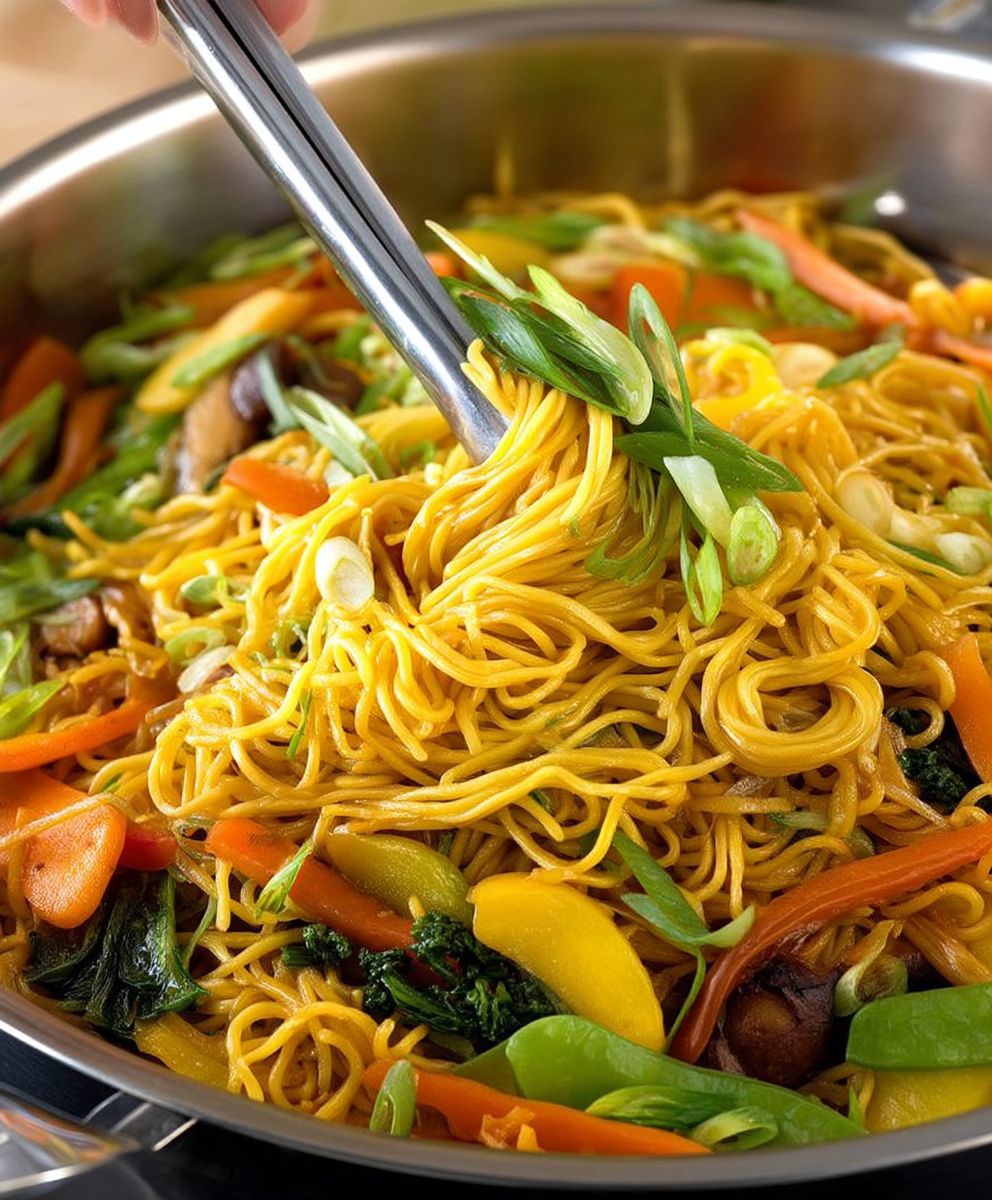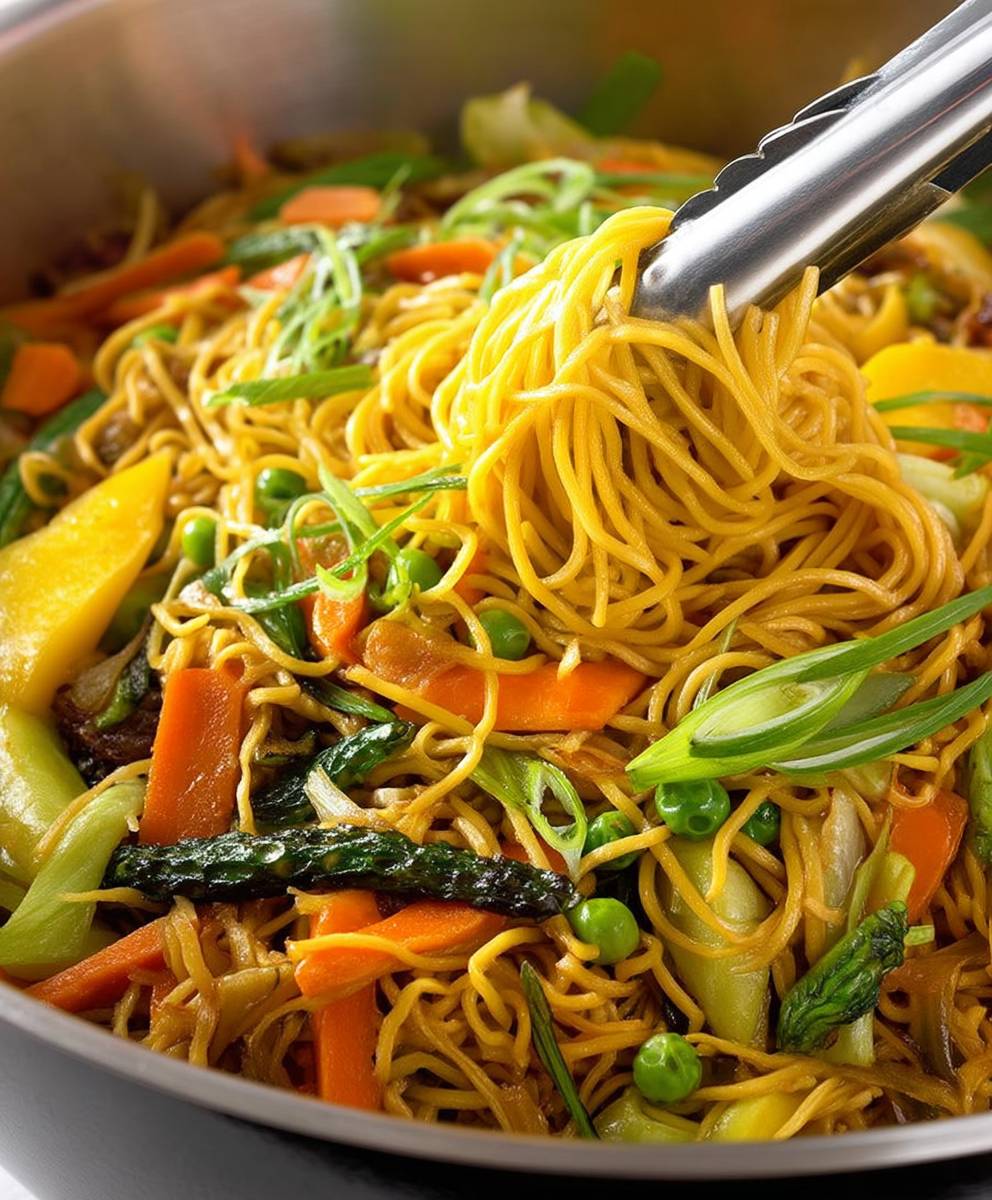Vegetable Chow Mein, a symphony of stir-fried noodles and vibrant vegetables, is more than just a quick and easy meal; it’s a culinary journey that tantalizes the taste buds and nourishes the body. Have you ever craved a dish that’s both satisfyingly savory and packed with wholesome goodness? Then look no further! This recipe delivers on all fronts, offering a delightful combination of textures and flavors that will leave you wanting more.
Chow Mein, meaning “stir-fried noodles,” boasts a rich history rooted in Chinese cuisine. While its exact origins are debated, it’s widely believed to have evolved from simple noodle dishes prepared by street vendors in northern China. Over time, it spread throughout the country and eventually made its way to the West, where it has been adapted and embraced by countless cultures. The beauty of Vegetable Chow Mein lies in its versatility. It’s a blank canvas for your culinary creativity, allowing you to incorporate your favorite vegetables and sauces to create a personalized masterpiece.
People adore this dish for its incredible taste, the satisfying chewiness of the noodles, and the delightful crunch of the vegetables. It’s also incredibly convenient, making it a perfect weeknight meal for busy individuals and families. Plus, it’s a fantastic way to sneak in extra veggies for those who may be a little hesitant to eat them otherwise. So, are you ready to embark on a flavorful adventure? Let’s get cooking!
Ingredients:
- 1 pound fresh Chinese egg noodles (or dried, cooked according to package directions)
- 2 tablespoons sesame oil, divided
- 1 large onion, thinly sliced
- 2 cloves garlic, minced
- 1 inch ginger, grated
- 1 red bell pepper, thinly sliced
- 1 green bell pepper, thinly sliced
- 1 cup sliced carrots
- 1 cup sliced mushrooms (shiitake, cremini, or button)
- 1 cup broccoli florets
- 1 cup snow peas, trimmed
- 1/2 cup sliced green onions, for garnish
- 2 tablespoons soy sauce
- 1 tablespoon oyster sauce (optional, but adds great flavor)
- 1 tablespoon rice vinegar
- 1 teaspoon sugar
- 1/2 teaspoon ground white pepper
- 1/4 teaspoon red pepper flakes (optional, for heat)
- 1/4 cup vegetable broth (or water)
- 1 tablespoon cornstarch
- Salt and pepper to taste
- Optional toppings: toasted sesame seeds, sriracha
Preparing the Noodles:
The key to great chow mein is perfectly cooked noodles. Whether you’re using fresh or dried, this step is crucial. I prefer fresh egg noodles for their texture, but dried works just as well.
- If using fresh noodles: Bring a large pot of water to a boil. Add the noodles and cook for 2-3 minutes, or until just tender. Be careful not to overcook them, as they will become mushy. Drain the noodles immediately and rinse with cold water to stop the cooking process. Toss with 1 tablespoon of sesame oil to prevent sticking.
- If using dried noodles: Follow the package directions for cooking. Usually, this involves boiling the noodles until al dente, then draining and rinsing with cold water. Toss with 1 tablespoon of sesame oil to prevent sticking.
Preparing the Sauce:
The sauce is what brings all the flavors together in this chow mein. It’s a simple combination of savory, sweet, and tangy ingredients that perfectly complements the vegetables and noodles.
- In a small bowl, whisk together the soy sauce, oyster sauce (if using), rice vinegar, sugar, white pepper, and red pepper flakes (if using).
- In a separate small bowl, whisk together the vegetable broth (or water) and cornstarch until smooth. This will be used to thicken the sauce.
- Set both bowls aside.
Stir-Frying the Vegetables:
Stir-frying is all about speed and high heat. Make sure you have all your vegetables prepped and ready to go before you start cooking. This will ensure that everything cooks evenly and doesn’t become soggy.
- Heat a large wok or skillet over high heat. Add 1 tablespoon of sesame oil.
- Add the sliced onion and cook for 2-3 minutes, or until softened and slightly translucent.
- Add the minced garlic and grated ginger and cook for 30 seconds, or until fragrant. Be careful not to burn the garlic.
- Add the sliced bell peppers, carrots, and mushrooms. Stir-fry for 3-4 minutes, or until slightly softened.
- Add the broccoli florets and snow peas. Stir-fry for another 2-3 minutes, or until the broccoli is bright green and the snow peas are crisp-tender.
- Season the vegetables with salt and pepper to taste.
Combining Noodles, Vegetables, and Sauce:
This is where the magic happens! We’re bringing everything together to create the perfect bowl of vegetable chow mein.
- Add the cooked noodles to the wok or skillet with the vegetables.
- Pour the sauce over the noodles and vegetables.
- Stir-fry for 2-3 minutes, tossing constantly, until the noodles are evenly coated with the sauce and heated through.
- Pour the cornstarch slurry into the wok or skillet. Stir-fry for 1-2 minutes, or until the sauce has thickened and become glossy.
Serving:
Now it’s time to enjoy your delicious homemade vegetable chow mein! I like to garnish mine with fresh green onions and a sprinkle of sesame seeds, but feel free to get creative with your toppings.
- Remove the chow mein from the heat and transfer it to serving bowls.
- Garnish with sliced green onions and toasted sesame seeds.
- Serve immediately.
- Optional: Add a drizzle of sriracha for extra heat.
Tips for the Best Vegetable Chow Mein:
- Don’t overcrowd the wok: If you’re making a large batch, it’s best to cook the vegetables in batches to ensure they cook evenly. Overcrowding the wok will lower the temperature and cause the vegetables to steam instead of stir-fry.
- Use high heat: Stir-frying requires high heat to quickly cook the vegetables and create that signature wok hei flavor. Make sure your wok or skillet is screaming hot before you add the ingredients.
- Prep all your ingredients beforehand: Stir-frying is a fast-paced cooking method, so it’s important to have all your vegetables chopped and your sauce prepared before you start cooking. This will prevent you from scrambling and ensure that everything cooks properly.
- Adjust the sauce to your liking: The sauce recipe is just a guideline. Feel free to adjust the amount of soy sauce, oyster sauce, rice vinegar, and sugar to suit your taste.
- Add protein: If you want to add some protein to your chow mein, you can add tofu, chicken, shrimp, or beef. Just make sure to cook the protein separately and add it to the wok or skillet along with the vegetables.
- Use different vegetables: Feel free to substitute any of the vegetables in the recipe with your favorites. Some other great options include bok choy, napa cabbage, bean sprouts, and water chestnuts.
- Make it gluten-free: To make this recipe gluten-free, use gluten-free soy sauce and tamari instead of oyster sauce. You can also use rice noodles instead of egg noodles.
- Storage: Leftover chow mein can be stored in an airtight container in the refrigerator for up to 3 days. Reheat in a wok or skillet over medium heat until heated through. You may need to add a splash of water or vegetable broth to prevent the noodles from drying out.
Variations:
- Chicken Chow Mein: Add cooked chicken breast, sliced into bite-sized pieces, to the wok along with the vegetables.
- Shrimp Chow Mein: Add cooked shrimp to the wok along with the vegetables.
- Beef Chow Mein: Add thinly sliced beef to the wok and cook until browned before adding the vegetables.
- Tofu Chow Mein: Add cubed and pan-fried tofu to the wok along with the vegetables.
- Spicy Chow Mein: Add more red pepper flakes or a drizzle of chili oil to the sauce for extra heat.
Enjoy your delicious and customizable Vegetable Chow Mein!

Conclusion:
And there you have it! This Vegetable Chow Mein recipe isn’t just another weeknight dinner option; it’s a vibrant, flavorful, and incredibly satisfying meal that’s guaranteed to become a new family favorite. I truly believe that once you try it, you’ll understand why I’m so excited to share it with you.
What makes this recipe a must-try? First and foremost, it’s incredibly versatile. You can easily adapt it to use whatever vegetables you have on hand, making it a fantastic way to clean out your fridge and reduce food waste. Got some leftover broccoli florets? Toss them in! A bell pepper that’s starting to look a little sad? Chop it up and add it to the mix! The possibilities are truly endless.
Beyond its adaptability, this Vegetable Chow Mein is also surprisingly quick and easy to make. From start to finish, you can have a delicious and healthy meal on the table in under 30 minutes, making it perfect for busy weeknights when you don’t have a lot of time to cook. And let’s be honest, who doesn’t love a quick and easy meal that’s also packed with flavor?
But the real magic of this recipe lies in the sauce. It’s a perfect balance of sweet, savory, and umami, and it coats the noodles and vegetables beautifully, creating a truly irresistible dish. The combination of soy sauce, sesame oil, ginger, and garlic creates a depth of flavor that will have you coming back for seconds (and maybe even thirds!).
Now, let’s talk about serving suggestions and variations. While this Vegetable Chow Mein is delicious on its own, it also pairs perfectly with a variety of other dishes. Serve it alongside some crispy spring rolls or potstickers for a complete and satisfying Asian-inspired meal. Or, if you’re looking for something a little lighter, try pairing it with a simple green salad.
For variations, consider adding some protein to the mix. Tofu, chicken, shrimp, or beef would all be delicious additions. Simply cook the protein separately and then add it to the noodles and vegetables during the final step. You could also experiment with different types of noodles. While I personally love using egg noodles for this recipe, you could also use rice noodles, udon noodles, or even spaghetti.
Another fun variation is to add a little bit of heat to the dish. A pinch of red pepper flakes or a drizzle of sriracha will add a nice kick that will really wake up your taste buds. You could also try adding some chopped peanuts or cashews for a bit of crunch.
I’m so confident that you’re going to love this Vegetable Chow Mein recipe. It’s a delicious, versatile, and easy-to-make meal that’s perfect for any occasion. So, what are you waiting for? Head to the kitchen and give it a try!
And most importantly, I want to hear about your experience! Did you make any modifications to the recipe? What vegetables did you use? What did your family think? Share your photos and stories with me in the comments below. I can’t wait to see what you create! Happy cooking! I hope you enjoy this recipe as much as I do. Don’t forget to rate the recipe after you’ve tried it! Your feedback helps others discover this amazing dish.
Vegetable Chow Mein: Quick & Easy Recipe You'll Love
Quick and easy Vegetable Chow Mein packed with fresh veggies and flavorful sauce. A customizable and delicious weeknight meal!
Ingredients
- 1 pound fresh Chinese egg noodles (or dried, cooked according to package directions)
- 2 tablespoons sesame oil, divided
- 1 large onion, thinly sliced
- 2 cloves garlic, minced
- 1 inch ginger, grated
- 1 red bell pepper, thinly sliced
- 1 green bell pepper, thinly sliced
- 1 cup sliced carrots
- 1 cup sliced mushrooms (shiitake, cremini, or button)
- 1 cup broccoli florets
- 1 cup snow peas, trimmed
- 1/2 cup sliced green onions, for garnish
- 2 tablespoons soy sauce
- 1 tablespoon oyster sauce (optional, but adds great flavor)
- 1 tablespoon rice vinegar
- 1 teaspoon sugar
- 1/2 teaspoon ground white pepper
- 1/4 teaspoon red pepper flakes (optional, for heat)
- 1/4 cup vegetable broth (or water)
- 1 tablespoon cornstarch
- Salt and pepper to taste
- Optional toppings: toasted sesame seeds, sriracha
Instructions
- Bring a large pot of water to a boil. Add the noodles and cook for 2-3 minutes, or until just tender. Be careful not to overcook them, as they will become mushy. Drain the noodles immediately and rinse with cold water to stop the cooking process. Toss with 1 tablespoon of sesame oil to prevent sticking.
- Follow the package directions for cooking. Usually, this involves boiling the noodles until al dente, then draining and rinsing with cold water. Toss with 1 tablespoon of sesame oil to prevent sticking.
- In a small bowl, whisk together the soy sauce, oyster sauce (if using), rice vinegar, sugar, white pepper, and red pepper flakes (if using).
- In a separate small bowl, whisk together the vegetable broth (or water) and cornstarch until smooth. This will be used to thicken the sauce.
- Set both bowls aside.
- Heat a large wok or skillet over high heat. Add 1 tablespoon of sesame oil.
- Add the sliced onion and cook for 2-3 minutes, or until softened and slightly translucent.
- Add the minced garlic and grated ginger and cook for 30 seconds, or until fragrant. Be careful not to burn the garlic.
- Add the sliced bell peppers, carrots, and mushrooms. Stir-fry for 3-4 minutes, or until slightly softened.
- Add the broccoli florets and snow peas. Stir-fry for another 2-3 minutes, or until the broccoli is bright green and the snow peas are crisp-tender.
- Season the vegetables with salt and pepper to taste.
- Add the cooked noodles to the wok or skillet with the vegetables.
- Pour the sauce over the noodles and vegetables.
- Stir-fry for 2-3 minutes, tossing constantly, until the noodles are evenly coated with the sauce and heated through.
- Pour the cornstarch slurry into the wok or skillet. Stir-fry for 1-2 minutes, or until the sauce has thickened and become glossy.
- Remove the chow mein from the heat and transfer it to serving bowls.
- Garnish with sliced green onions and toasted sesame seeds.
- Serve immediately.
- Optional: Add a drizzle of sriracha for extra heat.
Notes
- Don’t overcrowd the wok: If you’re making a large batch, it’s best to cook the vegetables in batches to ensure they cook evenly. Overcrowding the wok will lower the temperature and cause the vegetables to steam instead of stir-fry.
- Use high heat: Stir-frying requires high heat to quickly cook the vegetables and create that signature wok hei flavor. Make sure your wok or skillet is screaming hot before you add the ingredients.
- Prep all your ingredients beforehand: Stir-frying is a fast-paced cooking method, so it’s important to have all your vegetables chopped and your sauce prepared before you start cooking. This will prevent you from scrambling and ensure that everything cooks properly.
- Adjust the sauce to your liking: The sauce recipe is just a guideline. Feel free to adjust the amount of soy sauce, oyster sauce, rice vinegar, and sugar to suit your taste.
- Add protein: If you want to add some protein to your chow mein, you can add tofu, chicken, shrimp, or beef. Just make sure to cook the protein separately and add it to the wok or skillet along with the vegetables.
- Use different vegetables: Feel free to substitute any of the vegetables in the recipe with your favorites. Some other great options include bok choy, napa cabbage, bean sprouts, and water chestnuts.
- Make it gluten-free: To make this recipe gluten-free, use gluten-free soy sauce and tamari instead of oyster sauce. You can also use rice noodles instead of egg noodles.
- Storage: Leftover chow mein can be stored in an airtight container in the refrigerator for up to 3 days. Reheat in a wok or skillet over medium heat until heated through. You may need to add a splash of water or vegetable broth to prevent the noodles from drying out.

